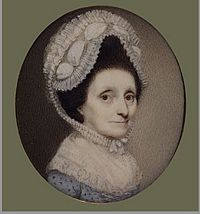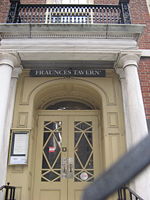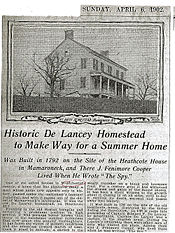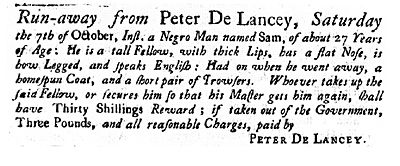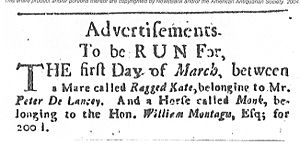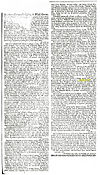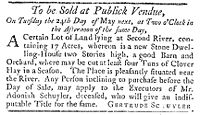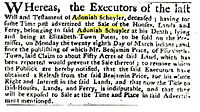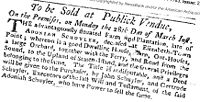User:AdibaIFrom The Peopling of New York City
Research ProposalI chose to do research on the slaves that were accused in 1741 over the women from the Triangle Factory for a number of reasons. These include previous knowledge/lack thereof, the amount of time that the slave issue existed, the curiosity for what had occurred to these slaves’ futures, and because of the more likely diversity of the new information that may emerge from slaves research than female workers research.(even though I am not sure this is correct, this is how it seems to me). In past history classes, The Triangle Waist Factory fire has been repeatedly introduced to me. We basically learned the context and why it was such a big issue. However, never did the teacher mention a slave conspiracy in New York. After reading New Tork Burning, I was surprised by the horrendous activities that went on in 1741 in New York and I think I would like to learn more about it and maybe eventually understand why it is often not mentioned in classes. We often discussed how slavery began and ended in America. The South was always emphasized in this topic as the main promoter for slavery while the north was virtually ignored. Learning that slavery actually caused such tremendous changes in New York of all places makes me more interested in what exactly happened. Additionally, it seems to me that the slave issue always existed and it gradually evolved to the status salves attained in 1741. Because the slaves had such a long history, I am more interested in where specific slaves ended up and if their future (the present) somehow reflects the past in terms of social, economic, or educational status, among other information. In addition to learning about the slaves’ lives, I hope to get an understanding of the owners themselves: did their families always have slaves? What is their origin and how did it affect their view on slaver? Did they just grow up with it and that’s why they had slaves too or? Did they ever allow the slaves some sort of freedom and flexibility to breathe or were they just cruel and selfish? Have these slave owners influenced the city in any way and vice versa? How did they respond to new laws regarding slavery as they were being made? Hopefully, by looking up information on particular slaves’ owners, I will get some answers to my questions and a better feel for what really happened since no one is sure anyway. The Actual ResearchThe search for the elusive immigrant involves so much painstaking work until one finally finds correct information that relates to the specific person being searched. While searching for my five immigrants of the 18th Century, I needed to go through different databases to find whether the information I was finding was consistent. Such an approach wasn't so helpful for me in the end since there were so many different people of the same name and there were contradictory information. How do I go about looking for information if I'm not even sure of the people I'm dealing with? The way I decided to go about it, therefore, was to try to eliminate certain people based on little details that I know cannot be true for my list of people. However, even this was difficult and, therefore, every little piece of information I did find was precious for the research process.
George BrinkerhoffGeorge Brinkerhoff was a merchant from the Dock Ward with 40 pounds of wealth who was not affiliated with any party. He owned a slave, Tom, who was mentioned but not accused. When I visited the New York Public Library, I checked the index for New York Passenger and Immigrant lists and I did not find George Brinkerhoff's name. The librarian then provided me with some old pages that were once part of a book that had information on the Brinkerhoff genealogy. It included a few points about the actual spelling of the last name, Brinkerhoff. It can sometimes be found as Brinkerhoof, Brinckerhoff, and even Blinkerhoff. When I first found this, I thought this would be some useful information for further research on George Brinkerhoff. However, I never came to any conclusions on this elusive immigrant. The same source spoke of a George Brinkerhoff who was born in New Jersey in 1735 and died there about 1790 with 6 children. However, after searching ancestry.com and different databases, I came across many George Brinkerhoffs in 1700s, which further complicated the findings I searched the familySearach database at the New York Public Library and based on the international genealogical index - North America there seems to be only a few different George Brinkerhoff's. There is one who kept on showing up all the time. However, even his information was very different: there is agreement that he was born in 1726 (most likely October) and died in 1797 (most likely December) but the place of birth was different for the same birth and death years, which included different neighborhoods in Queens, NY, 2 other places in New York (not in Queens) or New Jersey. Based on this research, I now think that the source I spoke of before (the old pages) does not refer to the same George Brinkerhoff in New York Burning, but there is nothing to confirm that either. After realizing that the ancestry.com and familysearch databases were of no use without other information, I decided to type in 'George Brinkerhoff' in search fields on the NYPL, New York Historical Society site, and Google Books. The former two did not yield any results. Using Google Books, most of information on George Brinkerhoff I found did not contain specific information such as occupation. Therefore, I couldn't have just assumed it was the right person since I already knew, based on acestry.com and familysearch, that there were more than one George Brinkerhoff living in New York during the 18th century. The only piece of information that I was able to take down was one that was consistent with the ward Brinkerhoff was living in: George Brinkerhoff was assistant alderman of the Dock Ward in New York from 1740 to 1749.[1] Peter DeLanceyPeter DeLancey was a French merchant affiliated with the Court Party. His slave, Albany, was accused but not arrested. I began my research on Peter Delancey on ancestry.com and familysearch at the NYPL. Because there was more than one Peter DeLancey and although all the information seemed to be leading to one specific person there was not sufficient information to eliminate all the other ones until it was confirmed by the inconsistent information such as year dates that were associated with other Peter Delanceys. After this confirmation I was able to more easily search for specific information regarding Peter DeLancey from New York Burning. With the preliminary research I also found that Delancey and De Lancey are interchangeable.
Peter DeLancey is from the the DeLancey's that were a French nobility in France. His father, Stephen DeLancey, was born on October 24, 1663 in Caen, Normandie Province, France. His parents, and thus Peter's grandparents, were Seigneur Jacques de Lancy and Marguerite Bertrand.[5] (I searched on the title 'seigneur' and found that it was used for someone who had a lot of land and became a feudal lord.) Stephen DeLancey moved from France after the Edict of Nantes was revoked in 1685 to Holland, then to London, and then to NY. He sailed to New York on March 20, 1686 and arrived on June 7, 1686. In New York City, Stephen DeLancey became a merchant and was quite influential in his town. He even represented the city at one point. He used his money very wisely to help the public. For example, he helped introduce (with John Moore) the use of fire-engines in New York in 1731.[6] Based on the continuous popup of James Delancey's name, it seemed that he was the one that took after him in becoming as influential as he was in public affairs.) Stephen Delancey married Anna van Cortlandt on January 19 1700. They had 7 children: James, Peter, Oliver, Stephen, Susan, who married Admiral Sir Peter Warren, and Ann, who married John Watts, Senior.[7] James Delancey was appointed Chief Justice of New York in 1733 and in 1753 he became Lieutenant Governor. Oliver Delancey served in the French and Indian War, was elected to House of Assembly in 1759, and became a Member of the Council in 1760.[8] Peter Delancey married Elizabeth Colden and had 12 children: 1.Stephen, who was named after his grandfather. He was a lawyer, Recorder of Albany, and Clerk of Tyron County 2.John, who was a Member of the Assembly from Westchester County and High Sheriff of that county. He married a Miss Wickham. 3.Peter, who became a lawyer of Charleston, South Carolina. 4. Anne, who married Joh Coxe of Philadelphia. 5.Alice, who married Ralph Izard of South Carolina, a delegate to the Continental Congress and a US senator from South Carolina. 6.Elizabeth, who died unmarried. 7.James, who was High Sheriff of Westchester County and a Tory during the Revolution. In Nova Scotia he was appointed a Member of the Council in 1794 and died there in 1800. 8.Oliver, who was born in West Farms. He resigned his Lieutenancy in the British Navy because of his loyalty to America at the time of the Revolution. He died in Westchester on September 4, 1820. 9.Susanna, who married Colonel Thomas Barclay 10.Warren, who was drowned during his childhood. 11. Warren, who ran away from home to join the British forces. He was made a Cornet of Horse for his bravery at the Battle of White Plains. He then moved to Madison County, New York. 12. Jane, who was born on September, 5 and died on March 2, 1809. She married her cousin, John Watts, Junior, the son of John Watts, Senior.[9]
To his son, Peter, he wrote "all my mills, mill houses, mill boat, farm and lands situate in Westchester County, upon the Bronx river." Peter also received from him 3,000 pounds. Peter Delancey became known as "Peter of the Mills" because of his posession of this valuable property on the banks of the Bronx River.[11] Peter Delancey left his estate amongst 10 children and his Widow, whose share was later given to the youngest son when he came of age. All the buildings on the spot were burnt - 2 dwelling houses, 3 stories, and 2 stables. At first it was thought that the fire was accidental but reports then caused the Delanceys to believe it to have been on purpose. On record is the fact that Susanna had 1/11 of the estate of her father which consists of "divers Lots and houses" in New York. This estate was actually left undivided until 1782 and Susanna obtained one share. The whole estate was worth 7000 pounds. However, after the destruction of the houses by the fire Susanna Barclay sold her share for 250 pounds.[12] Pictured on the right is an article that attests to the prominence of the Delancey's and their property, specifically in Westchester.[13]
Peter DeLancey was a member of the Assembly from Westchester County for many years, and was High Sheriff of Westchester County.[14] He defeated Lewis Morris for a New York Assembly seat in Westchester County in 1752. When this happened, Morris complained that Peter used "threatening and bribery...barefacedly" but he did not follow with ths claim.[15]
My next stop was the New York Historical Society. I searched on the society's catalog for Peter Delancey. I found some books that I already looked at by the New York Public Library and some papers that, according to site, can only be used by "qualified researchers". As soon as I got excited that I found manuscripts which included information on Peter Delancey I was let down by the statement about qualified researchers. However, after speaking to the person in charge of the manuscripts I found that I was able to and quickly gave him the call numbers to Family Papers by James Delancey and the Family Papers by Nicolls Colins which, according to the site, included information on the Delancey family. The manuscript director then returned with 3 huge boxes of manuscripts by James Delancey and a 2 small ones for Colins and I quickly began to pore over the ancient ripped papers from the 1700s. I really felt like a historian at that point. They included receipts, invoices, coresspondences, wills, indentures, and legal documents. It was so hard to decipher the handwriting but nevertheless I went about to search for the name Peter Delancey through the hundreds of papers by trying to narrow down where I might find him. Much to my disappointment, I could not find anything on him through these papers. I searched and searched until I had to return them because they were closing. But I have to admit, it was kind of cool looking through actual papers from the 1700s. (I actually found it interesting the way they used to "staple" papers together.) While researching for information on Peter Delancey, I found that his children continued to hold the high status of the Delanceys. Many books that mentioned Peter for just a sentence or so were either about or included information on his children. Up to now, I did not take note of the stories and facts I found on his children because I was focusing on Peter Delancey. However, because I didn't seem to find any more information besides for what I already have found, I decided to move on to research on some of his children and the legacy Peter Delancey left behind. Ironically, when I started doing this, I found a little more on Peter Delancey and it pushed me to keep searching for him. I then realized there was no more time to organize specific narratives on the children. Along the way, two other interesting advertisements regarding Peter Delancey are below. I am unsure of their significance. I tried searching on google and Google Books but have not found anything on them.
.....
John LathamJohn Latham was an English ship's carpenter from Montgomery Ward with a wealth of 15 pounds and slave named Fortune. At first I thought that he got married to an Agnes Johnston on April 18, 1734, but now I am not sure. After searching on familysearch.org and databases at the New York Public Library. I found an overwhelming number of John Lathams from the 18th century. No matter where I looked or how I compared the information, I was not able to come to any conclusions. Adoniah SchuylerAdoniah Schuyler was a Dutch immigrant with 40 pounds wealth with no party affiliation. He was a slave trader in the East Ward. His slave, Lewis, was ultimately transported. (Based on Horsemanden's journal, Lewis was transported to Madeira.[20] During my preliminary research, searching for Adoniah Schuyler caused some frustration. Whenever I thought I found some good information on him, I would find the same information somewhere else but with contradictory statements. For example, I found an Adoniah Schuyler who was born in 1717 and died in 1763. His father was Arent Philipse Schuyler and his mother was Jenneke Teller. However, I found elsewhere an Adoniah Schuyler with the exact parents yet the birth year was 1705 and and the death year was 1763. To top it, I found other Adoniah Schuylers too. Basically, this guy was annoying. Also, I was not able to utilize the newspaper articles I found that spoke of an Adoniah Schuyler during eighteenth century until I found specific information on the Adoniah I was searching. After searching some more on the New York Public Library's databases, I concluded the following: although there were many birth years for Adoniah Schuyler, his parents were either Arent (Philipse) Schuyler and Jenneke Teller or David (Pieterse) Schuyler and Anna Bratt. In some places, it said that the wife of Arent Schuyler was Swantje Dyckhouse (alternate spelling: Swantie van Duyck Huysen).[21] With the following approach I finally was able to figure out who the "real" Adoniah Schuyler was. I realized that looking for a specific piece of information that corresponds to the given facts about Adoniah in New York Burning was not the right approach for Adoniah Schuyler. Therefore, although there were many many files on Adoniah Schuyler and there seemed to be a lot people with the same name at the time, I decided to compare all the information side by side. After doing so, I concluded that there seemed to have been only 2 different Adoniah Schuylers with a lot of their information recorded incorrectly which led to a lot of confusion and many different files on them.[22] The first Adoniah Schuyler, who I thought was the person Jill Lepore was referring to, was an Adoniah Schuyler with the father Arent Aschuyler. The second one was an Adoniah Schuyler with the father David Schuyler. The many different files resulted from many different birth years recorded and the different names of the mother of the first Adoniah Schuyler. The birth years for the first Adoniah Schuyler ranged from 1705 to 1720 with most of them around the year 1708 and a few at 1717. The birth years for the second Adoniah Schuyler ranged from 1720 to 1727 with most at 1726. I decided that it was probably the first person I would deal with since the second Adoniah Schuyler would have been about 15 years old in 1741 and I am assuming that a 15 year old probably did not have his own slaves or have had a significant influence. With this solved, I finally was able to go on with my research on Adoniah Schuyler. Adoniah Schuyler was born around 1706 in Elizabethtown, Essex Co., NJ (or New Barbados, NJ) and died Elizabethtown in May 1762 (or sometime in 1763). His father is Arent Philipse Schuyler and his mother is Jenneke Teller, also named Swantje Dykhouse (later when I visited the New York Historical Society I found that they are not the same person). Adoniah Schuyler was married to Gertrude Van Renesselaer (or Gurtruy or Geertruy) in 1734 or 1740 in Albany, NY. His children were Ranslaer, Mary, Swan, John, Peter, Adoniah, and Philipp.[23]
After visiting the New York Historical Society, I was able to compile a significant amount of information on Adoniah Schuyler's father that explains how Adoniah Schuyler obtained the status and wealth he had in New York. Adoniah Schuyler's father, Arent Schuyler, was the 4th son of Philip Schuyler and Margarita van Slichtenhorst. He was born in Beverwyck on June 25 1662. He received a sufficient education for a business life and that's what he did. On November 26, 1684 he married Jenneke Teller, daughter of William Teller who emigrated from Holland in 1693 and had settled in Albany and was employed by the Dutch West India Company.[27] After his marriage, Arent and his wife made a joint will, written in Dutch, that is still preserved in Albany today. Later, he was commissioned a captain and at times was active in politics as well. He also dealt a lot with the Indians of New York. For example, Arent commanded a militia in February 1693 when the French and Indians were driven from the Mohawk couny by Major Peter Schuyler. After being militarily active, he moved from to New York to Pompton.[28] After Jenneke Teller died in 1700 he marred a second wife, Swantje Dyckhyse in 1703 and made a second will which would divide his estate among all his children.[29]He lived in Pompton until 1710 when he moved to a large farm he purchased from Isaac Kingsland on New Barbados Neck, east side of Passaic River. On this property, a negroe slave discovered a copper mine which made him extremely prosperous. He built a house and bought even more lands. Later, he gave this land to his eldest son, Philip. The lands he bough near Bordentown were given to his second son, Casparus. Lands on the Rahway at Elizabethtown were given to his son, Pter. Houses and lots in New York City were given to his daughters, Even and Cornelia. The homestead, with ists lands and parks, were for John. Finally, the lands at Eliabethtown were given to his son, Adoniah.[30] After his second wife died, he married a third wife, Maria Walter, daughter of Robert Walter and granddaughter of Jacob Lesler,[31] and made a third will. With this third will, he gave to Adoniah his large house and tract and pieces of land, and the house and small pieces of land at Elizabethtown Point" which was on top of the previous lands he received. Additionally, ohn, Peter, and Adoniah would obtain the profits of the mine equally.[32] Adoniah Schuyler left the copper mine to be managed by his brother. Instead, he established himself as a merchant in New York City where he acquired great wealth and obtained a high social position. He later increased the value of his large estate at Elizabethtown Point by establishing a ferry to Staten Island.[33] This led to the establishment of Staten Island Ferry Co.[34] It was said that Adoniah Schyler's slaves were so fond of him that they refused their freedom when Adoniah offered to let them go.[35]He died around May 1762 leaving 7 children. Two of his sons, Renssalaer and Adoniah entered the British services. Renssaelaer became lieutenant in the British army and Adoniah,, who married Susan Shields of England became midshipman in the British navy and rose to the rank of captain. His other children were Mary, who married Captain Henry st John of the British navy, Swan, John, Peter, and Philip. His widow later married Robert Lvingston.[36]Addtionally, from Adoniah descentds a distinguished naval captain: Captain Arent Schuyler Crownshield.[37] Peter ValettePeter Valette was a French merchant and slave trader who lived in the East Ward with 110 pounds wealth and no party affiliation. His slave, Tom, was discharged. It is likely that Peter Valette from New York Burning was born around 1696 in New York and was maried to Maria Jay on June 29, 1723.[38] However, there is really nothing I found that can confirm this is true, especially after I found many more people from France with the same name, Peter Valette. Therefore, I was not able to use newspaper findings about a Peter Delancey. I tried searching for him on library catalogs by plugging in his name along with a specific detail that was given and even that did not bear any fruit.
References
|
